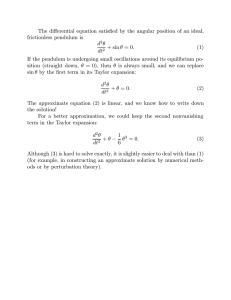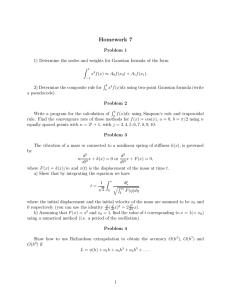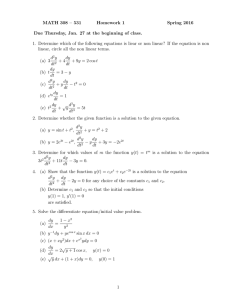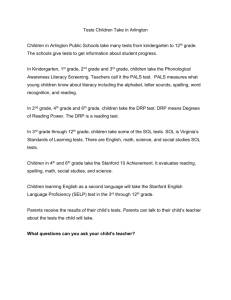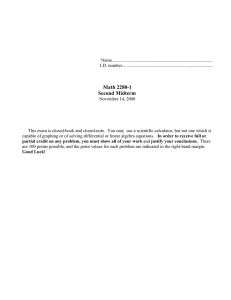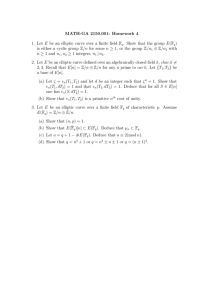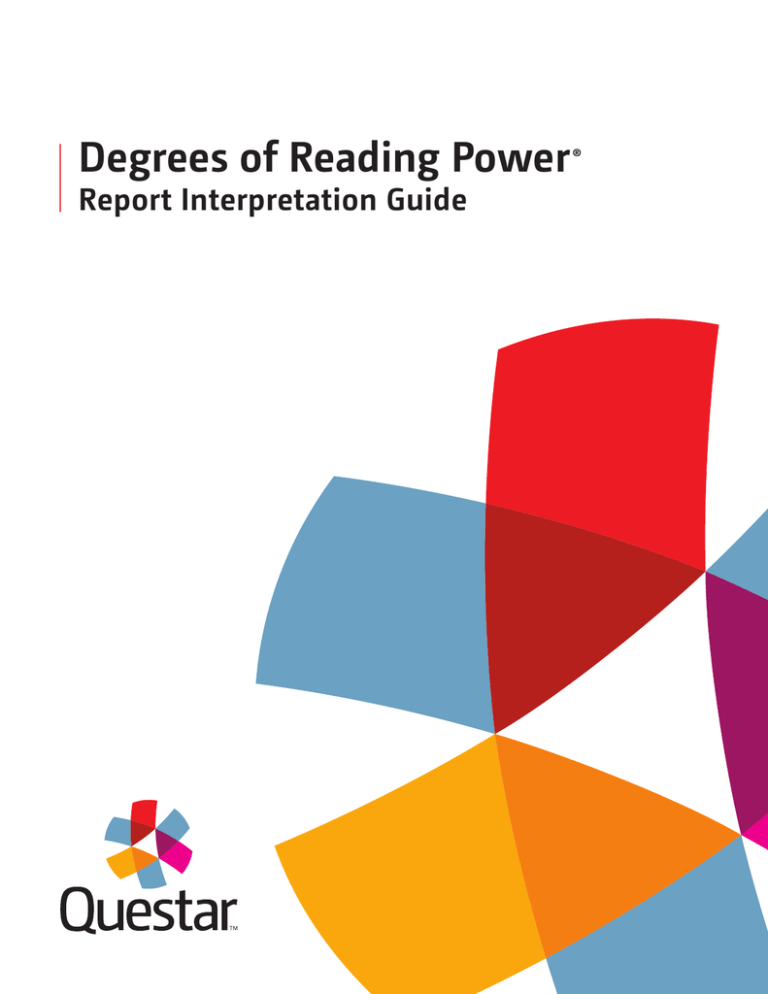
Degrees of Reading Power ®
Report Interpretation Guide
More detailed information about the DRP program,
including technical specifications, can be found in
the publication The DRP Handbook, available from
Questar Assessment Inc.
Degrees of Reading Power, DRP, and Success By Your Standards are registered trademarks of Questar Assessment Inc.
Copyright ©2016 by Questar Assessment Inc. No part of this publication may be reproduced and/or transmitted by any means
without the written permission of Questar Assessment, Inc. All rights reserved. Printed in the USA.
DRP TEST SCORES
DRP test scores are reported on a scale of text complexity. A percent, or level, of comprehension is
associated with each DRP test score. As the percent of comprehension increases, the complexity or
difficulty of the materials that a student can understand with that level of comprehension must decrease.
This is shown in the numbers below under the heading DRP Scores.
Student
Juanita Doe
DRP Test Form
DRP Scores
at various Percents or Levels of Comprehension
Raw Score
(No. of correct
items)
6A
35
Instructional
Independent
50%
70%
75%
80%
90%
68
60
57
54
46
All DRP test scores must be related to a specific percent, or level of comprehension. In other words, Juanita
can “read” materials as difficult as 68 DRP units, but with only 50% comprehension. However, for materials
as easy as 46 DRP units, Juanita can understand 90% of the text. This is often called the “Independent”
level of comprehension, because the student is not likely to need instructional support to comprehend
such text on her own.
Criterion-referenced DRP scores tell you what your students can read. You can use your DRP test results to:
• Set expectations and goals
• Monitor student progress in reading
• Guide classroom instruction
USE DRP SCORES TO SET EXPECTATIONS AND GOALS
One way to look at setting expectations and goals is to think about what students are expected to read at
each educational level. For example, students who plan to drive should be able to read their state’s driver’s
license manual (avg. DRP=64). The Common Core State Standards (CCSS) create a staircase of increasing
text complexity so that students are expected to develop their skills and apply them to more and more
complex texts.
The College and Career Readiness (CCR) Anchor Standard 10 for Reading states a major college and
career readiness goal:
“Read and comprehend complex literary
and informational texts independently and
proficiently...”
It is similarly worded as Standard 10 in each grade-level set of the CCSS in reading. The standards
leading up to Standard 10 emphasize the close, careful, and critical thinking/reading actions that lead to
comprehension of complex texts, even though they do not specify the underlying skills and strategies that
must be applied in order to achieve the independent comprehension goal. See correspondence of DRP text
complexity values and CCSS Grade Bands in the DRP Staircase of Text Complexity illustrated on page 2.
|1
DRP Staircase of Text Complexity
DRP Scale
80
Graduate School, College,
and Workplace
Above 70 DRP
(College & Career Readiness)
Grades
11−12
Grades
9−10
Grades
6−8
70
67−74 DRP
62−72 DRP
60
57−67 DRP
Grades
4−5
52−60 DRP
50
Grades
2−3
42−54 DRP
Grades
K−1
40
Below 44 DRP
30
Grades K−1
Grades 2−3
Grades 4−5
Grades 6−8
Grades 9−10
Grades 11−CCR
20
College & Career Readiness
CCSS Grade Bands
DRP reading goals based on CCSS end-of-year text complexity standards have been set at each grade level.
With multiple administrations of DRP tests during the school year, you can monitor students’ progress
toward those goals.
End-of-Year Text Complexity Standards by Grade in DRP Units (based on CCSS Grade Bands)
42–54 DRP
52–60 DRP
57–67 DRP
62–72 DRP
67–74 DRP
Gr 2
Gr 3
Gr 4
Gr 5
Gr 6
Gr 7
Gr 8
Gr 9
Gr 10
Gr 11
Gr 12
42–49
48–54
52–57
55–60
57–62
60–64
62–67
62–69
64–72
67–72
67–74
College
& Career
Readiness
(CCR) = 70 DRP
@ P=.90
Minimum Level of Comprehension for the Text Complexity Expectations above to be considered “On Grade” at end of school year:
Gr 2
2|
Gr 3
P=.70
Gr 4
Gr 5
Gr 6
P=.75
Gr 7
Gr 8
P=.80
Gr 9
Gr 10
Gr 11
P=.90
Gr 12
CCR
USE DRP SCORES TO MONITOR STUDENT PROGRESS IN READING
All DRP test scores are reported on the same equal-interval scale. A DRP score increase of 5 points in
grade 4 is equal to an increase of 5 points in grade 10. Thus, it is possible to measure individual growth in
reading and compare the level of growth among individuals or groups.*
Although there are enormous differences in ability to read and comprehend text among students, classes,
and schools, some generalizations can be made:
• S
tudents in grades 2 and 3 typically show rapid growth within a school year — as much as 10 DRP
units.
• G
rowth from grades 4 through 8 averages about 4 DRP units per year.
• In high school, growth from fall to spring is smaller — about 1-2 DRP units.
Teachers at all grade levels can monitor student progress in reading over time by administering DRP tests
as pretests and posttests. And because DRP test scores tell you what a student can read, progress can be
measured in those terms as well.
Reports describing student performance by CCSS comprehension clusters include
• Individual Performance Chart
• Alphabetical Roster
• CCSS Diagnostic Summary
USE DRP SCORES TO GUIDE CLASSROOM INSTRUCTION
The DRP scores shown on your score reports reflect the difficulty level of books your students should be
able to read and comprehend. This information can be useful both in selecting appropriate materials for
your students and in planning your classroom instruction.
DRP test scores can be used in two ways:
1. F
irst, the teacher can start with the DRP difficulty or text complexity of assigned instructional
materials in DRP units, and identify those students who can read the materials with a high level
of comprehension, as well as those who are able to read the materials with only a low level of
comprehension.
2. Second, the teacher can start with the students’ DRP test scores and use DRP➔BookLink to find
books that match the needed level of comprehension for assignments. The online DRP➔Analyzer
tool can also be used to determine the text complexity of locally developed texts or brief articles
being used for class instruction.
*When measuring growth, it is important to use DRP scores at the same level of comprehension, for
example, compare Independent Level (P=.90) pretest and posttest scores.
|3
MANAGE CLASSROOM INSTRUCTION
Using students’ DRP scores and published DRP readability information, teachers can
• D
etermine which books are more appropriate for classroom instruction and which for independent
reading
• D
etermine which students will need assistance with their reading assignments, and which students
can be expected to do more challenging work
• B
uild classroom reading collections that correspond in difficulty to the reading abilities of students in
their class
• U
se DRP➔BookLink software to generate summer reading lists. Books in the school library can also be
sorted and/or coded according to their difficulty level, helping students find books that are appropriate
in relation to their reading ability
Additionally, the passage sets on the DRP Tests contain a balance of three types of test items that
correspond to the three clusters of the CCR Anchor Standards for Reading and the CCSS Reading
Standards for Informational Text:
• Key Ideas and Details (CCR Anchor Standards 1–3 for Reading)
• Craft and Structure (CCR Anchor Standards 4–6 for Reading)
• Integration of Knowledge and Ideas (CCR Anchor Standards 7–9 for Reading)
For each of the three clusters, a CCSS diagnostic score (Teach, Practice, or Apply) is provided for each
student. These will assist teachers in differentiating instruction and in grouping students with similar needs
for intervention, reinforcement, and enrichment purposes.
TEXT COMPLEXITY, READING COMPREHENSION ABILITY, AND EFFECTIVE LEARNING
Students need to be able to comprehend their books and assigned texts if effective learning is to take
place. But how much comprehension is desirable, and under what conditions? If materials are too easy,
then students may become disengaged; if they are too hard, students often become frustrated. In either
case, effective learning is unlikely.
The amount of comprehension necessary for effective learning is influenced by many factors. Student
factors such as interest, motivation, study habits, and background knowledge are known to influence
effective learning. Similarly, the quality of the textbook, in the sense of being “considerate” for the intended
reader, is known to influence effective learning. However, three teacher-controlled factors are often the
most important influences. Stated as questions, these factors are:
1. W
hat is the purpose of reading?
If the assigned reading is for the purpose of acquiring or applying content knowledge, then the
student must be able to read the material with a higher level of comprehension. If the purpose for
reading is to improve the student’s reading ability, then the material must provide some challenge for
the student. In other words, the teacher would want to use materials that are more complex, relative
to the student’s reading ability. The students can be taught strategies that “stretch” their reading
comprehension abilities.
4|
2. What is the nature of the reading tasks?
If the reading involves “lower order cognition” such as minimally inferential reading for key ideas
and details, then the materials could be more complex relative to the student’s reading ability. On
the other hand, if the assigned task involves “higher order cognition” such as critical or evaluative
reading, then the student must be able to read the material with a higher level of comprehension.
3. What is the teacher’s role?
If the teacher’s primary role is to help the student read the assignment, then the material can and
should be more difficult and complex in relation to the student’s reading ability. The mid-instructional
level of 75% comprehension is often used (and/or 70% comprehension in early grades and/or
80% comprehension for grades 7 and up). However, often teachers expect the students to handle
the assigned materials on their own, providing little to no assistance to help the student read the
assignment. In such situations, the student must be able to read the materials with a higher level of
comprehension, often the independent level at 90% comprehension.
In our example on page 1, if Juanita were a 6th grade student and her social studies textbook had a
DRP complexity value of 60 DRP units, Juanita could be expected to experience some difficulty reading the
book. Her teacher may look for easier supplemental materials for Juanita. At the same time, the teacher
can use specific intervention strategies and scaffolding with Juanita in order to facilitate her understanding
of the textbook and to help Juanita internalize effective reading skills in the social studies content area.
However, the situation could be different. Juanita’s teacher may want to select a book for Juanita to read
and report about to the class. In this case, the teacher could suggest books for Juanita with DRP values in
the mid to high 40s — books for which Juanita’s level of comprehension is high, allowing her to evaluate
the ideas presented and synthesize the book’s content into her written and oral report.
|5
Exhibit 1: Individual Performance Chart
A
INDIVIDUAL PERFORMANCE CHART
DRP Core Comprehension Test Scores
District:
School:
Examiner:
Class:
Questar School District
Questar Middle School
District
Kim Smith
Smith, Kim 7-A
B
Student: KENNETH CORA
Grade: 7
Date of Test:
09/03/2015
In September, KENNETH took a Degrees of Reading Power (DRP) Core Comprehension Test. KENNETH's performance on this test is reported
and interpreted in the following table and chart.
Test Form:
7A
Instructional DRP (P=.80): 71
Key Ideas & Details:
Raw Score:
52 of 63
Independent DRP (P=.90): 63
Craft & Structure:
National %ile*:
81
C
D
E
Integration of Knowledge & Ideas:
21 of 21
Apply
12 of 16
Practice
19 of 26
Practice
The DRP Core Comprehension Test measures a student's ability to read and understand increasingly complex text. Three diagnostic scores indicate
the student's comprehension of key ideas and details, knowledge of vocabulary, and analysis of ideas developed within the text. An instructional
interpretation is provided to assist teachers in planning appropriate intervention or enrichment: Teach (Introduce), Practice or Apply.
Instructional DRP Scores indicate the most difficult text that a student can read with 80 percent comprehension.
Assistance from teachers or parents will be needed for students to read such materials with higher comprehension or to read more difficult texts.
Independent DRP Scores indicate the most difficult text that a student can read with 90 percent or higher comprehension.
Examples of the materials which KENNETH is able to comprehend are shown below. DRP text values provided in bold, Lexile® measures provided
in parentheses. KENNETH's Instructional DRP Score is plotted.
DRP
Score
DRP Unit
Scale
Difficulty of Materials at Various DRP Values
difficulty must be balanced with educators' professional judgment and students' knowledge, interests, and
78 Experimental Science Journals**
75 Professional Journals**
External
Benchmarks
70 College and Career Readiness (CCR)
68
64 State Driver's Manuals**
Books for Teens
and Young Adults
62
58
F
75
72
55 The Birchbark House (970L)
53 The Secret Garden (710L)
51 Bud, Not Buddy (950L)
50 Elementary School Textbooks**
49 Bat Loves the Night (AD560L)
70 First Year College Texts**
67
H
65 The Longitude Prize (1160L)
63 Vincent Van Gogh (1100L)
62 High School Textbooks**
61 Jane Eyre (890L)
59 A Night to Remember (950L)
57 I Know Why the Caged Bird Sings (1330L)
56 Middle School Textbooks**
55 The Adventures of Tom Sawyer (950L)
53
51 A Wrinkle in Time (740L)
47 Sunshine Makes the Seasons (AD510L)
Books for
Children
45 The Treasure (490L)
43 The Stories Julian Tells (520L)
41 Frog and Toad Together (330L)
40 Primary School Textbooks**
39 Inch by Inch (210L)
G
37 My Five Senses (AD400L)
34 Are You My Mother? (80L)
31 Green Eggs and Ham (30L)
25 Understands Simple Paragraphs
Paragraphs less
than 250 words
19 Begins to Understand Simple Paragraphs
** Average DRP Value
Date report generated: 10/02/2015
* Normative data based on 2000 National Norms reported for September.
Lexile® book measures are provided only as an additional resource. Their actual relationship to DRP book or student measures has yet to be determined.
Copyright ©2015 Questar Assessment, Inc. Degrees of Reading Power and DRP are registered trademarks. All Rights Reserved.
6|
THE INDIVIDUAL PERFORMANCE CHART
The Individual Performance Chart can be produced for each student tested. The table, shown in Exhibit 1,
shows the student’s performance in terms of instructional and independent comprehension levels. In
addition, three diagnostic scores reflect the CCSS clusters Key Ideas & Details, Craft & Structure, and
Integration of Knowledge & Ideas.
A
eport Type. An Individual Student Report can be generated to show the performance of each student
R
tested in a class, school building, or district.
B
Student Name. The student’s name is shown along with grade and date of testing.
C
Test Form, Raw Score, and National Percentile Rank are shown.
D
RP Scores. Student performance on DRP tests can be displayed in relation to various performance
D
benchmarks. In this example, the Instructional Level (P=.75) DRP Score was plotted in relation to the
average difficulty of articles in popular periodicals and selections from children’s literature. Although
both Independent Level and Instructional Level DRP Scores are reported, only one level is plotted on
the Individual Performance Chart. The typical practice is to plot the Instructional Level for students
in elementary and middle school, and the Independent Level for students in high school and beyond;
specifically, DRP Scores at (P=.70) for grades 2–4; DRP (P=.75) for grades 5–6; DRP (P=.80) for grades
7–8; and DRP (P=.90) for grades 9+. This reporting is consistent with the expectation that students in
the primary and elementary grades typically receive considerable assistance while they are learning to
read and that students in the middle and high school grades are expected to do most, if not all, of their
reading without assistance.
E
T he number of items the student answered correctly at each of the three CCSS Reading Skills Areas,
along with the corresponding interpretive suggestions are shown.
F
tudent’s score is plotted on the DRP Unit Scale and graphically illustrates student progress in
S
understanding increasingly difficult textual material.
G
erformance Benchmarks show materials that students at various levels will be able to comprehend.
P
In Exhibit 1, multiple performance standards have been selected to provide functional referents
for student performance and to reflect the developmental nature and progression of reading
comprehension over time and across grades. It is important to note that these performance
benchmarks were selected for illustrative purposes. In practice, any material containing continuous text
could be used to define reading performance benchmarks for students. For example, school districts or
state education departments could profile students’ progress toward locally determined reading goals
or standards of excellence using the difficulty of employment manuals, driver’s license manuals, or
environmental, health, or safety pamphlets.
H
L exile® book measures provided as an additional resource to identify text complexity of selected
materials.
|7
B
C
8|
D
A
E
F
G
H
I
J
K
L
District: Questar School District
School: Questar Elementary School
Exhibit 2: School Alphabetical Roster
ROSTER OF STUDENTS (ALPHABETICAL OR RANK ORDER)
The Alphabetical Roster can be produced for all the students in a class, school building, or district by grade,
and provides specific information about each student in the group tested, as well as measures of central
tendency (such as mean and median) for Raw Score, DRP Score, National Percentile Ranks, and CCSS
Comprehension Clusters (Key Ideas & Details, Craft & Structure, and Integration of Knowledge & Ideas).
A
eport Type. Reports can be generated that aggregate or summarize the performance of students for a
R
class, teacher, school building, or district, by grade.
B
tudent Name. Each student tested is listed alphabetically along with his/her scores, reported in a
S
variety of formats.
C
RP Scores represent a student’s reading ability in terms of the most difficult text that the student can
D
read with a given level of comprehension.
D
ational Percentile (NPR) indicates how the student’s performance compares to the performance of
N
students nationally.
E
CEs or Normal Curve Equivalents, are normalized standard scores that represent the performance of
N
a student relative to students in the norming sample. NCEs look like National Percentile Ranks (NPRs)
but are equivalent to NPRs only at the 1st, 50th, and 99th percentiles. The advantage of NCEs over
NPRs is that NCEs form an equal-interval scale, and therefore can be added and averaged to determine
group performance, or subtracted to measure gains.
F
Raw Score is the total number of correct answers.
G
Number Answered lists the total number of items attempted by the student.
H
umber Correct per Passage. Passages on DRP tests have seven items each. The passages are
N
sequenced in order of difficulty. When the passages are very easy relative to the student’s ability,
the typical response pattern is to get all of the items correct. As the passages become more difficult,
performance drops off. When this pattern of response varies, it could indicate either that the student
was guessing throughout, or that an item was accidentally skipped.
I
ey Ideas & Details lists the number of items of this type answered correctly by the student and the
K
Instructional Interpretation of that score.
J
raft & Structure lists the number of items of this type answered correctly by the student and the
C
Instructional Interpretation of that score.
K
Integration of Knowledge & Ideas lists the number of items of this type answered correctly by the
student and the Instructional Interpretation of that score.
L
erformance in Relation to the CCSS 10 for Reading shows student performance in relation to CCSS
P
grade level text complexity expectations for the end of the school year (Below Grade Level, On Grade
Level, or Above Grade Level).
|9
Exhibit 3: School Profile
A
District: Questar School District
School: Questar Elementary School
75
B
C
D
H
E
F
G
H
10 |
PROFILE REPORT
The Profile Report can be produced for a class, teacher, school building, or district, by grade. It is a
descriptive and graphic report designed to provide summary information about the group of students
tested, and shows the distribution of student performance and measures of central tendency (such as
mean and median) grouped by DRP reading levels.
A
eport Type. Reports can be generated that aggregate or summarize the performance of students for a
R
class, teacher, school building, or district, by grade.
B
requency Distribution. Indicates how many students scored at each point on the DRP scale, providing
F
a graphic representation of the range of abilities in the group.
C
RP Scale. DRP results are reported on a scale of text complexity. The DRP Scale of Text Complexity
D
ranges, in theory, from 0 to 100 units, with higher values indicating more difficult material.
D
erformance Benchmarks. Because DRP scores are reported on the same scale as text difficulty,
P
examples of materials that your students will be able to comprehend at various levels are shown here.
E
Raw Score is the total number of correct answers.
F
RP Scores represent a group’s average reading ability in terms of the most difficult text that they can
D
read with a given level of comprehension. For example, the first DRP score listed in the Independent
(P=.90) column, “42”, indicates that, on average, the students can read text with a DRP difficulty value
of 42 with about 90% comprehension. The “53” in the Instructional (P=.75) column indicates that
average students can read text with a DRP difficulty of 53 with about 75% comprehension.
G
ational Percentile Rank (NPR) indicates how the group’s performance compares to the performance
N
of students nationally. For example, a group whose percentile rank is 33 performed as well as or better
than 33% of the students in the national norming sample.
H
CCSS Text Complexity Expectation indicates the most difficult text (in DRP Units) that students at the
reported grade level should be able to read with the specified level of comprehension (70–90%) to be
“on” or “above” grade level by the end of the school year. The letter “A” (for above) and the letter “G”
(for on grade level) are marked on the DRP Unit Scale. The percent of reported students performing
Above, On, or Below Grade Level is also shown.
| 11
G
J
I
H
B
C
A
D
E
F
District: Questar School District
School: Questar Elementary School
Exhibit 4: District CCSS Diagnostic Summary
GRADE/SCHOOL DIAGNOSTIC SUMMARY
The Diagnostic Summary Report can be produced for a class, teacher, school building, or district, by
grade. This report shows the distribution of student performance grouped by instructional reading levels
according to the three major Common Core State Standards reading skills areas: Key Ideas & Details, Craft
& Structure, and Integration of Knowledge & Ideas.
12 |
A
Report Type. Reports can be generated that aggregate or summarize the performance of students for a
class; teacher; school building; or district, by grade.
B
Test Form. It is important to know which form students were initially tested with when making decisions
about retesting. You may want to retest with an alternate form.
C
umber of Items. This is the overall number of items on the test. DRP Tests have seven items per
N
passage.
D
Number of Students. This is the number of students whose results are included in the summary report.
E
Key Ideas & Details. The number of items assessing this reading cluster, along with the mean and
median number answered correctly, are shown.
F
raft & Structure. The number of items assessing this reading cluster, along with the mean and median
C
number answered correctly, are shown.
G
Integration of Knowledge & Ideas. The number of items assessing this reading cluster, along with the
mean and median number answered correctly, are shown.
H
pply. Lists the Raw Scores associated with this instructional reading level, along with the number and
A
percent of students scoring at that level.
I
Practice. Lists the Raw Scores associated with this instructional reading level, along with the number
and percent of students scoring at that level.
J
Teach. Lists the Raw Scores associated with this instructional reading level, along with the number and
percent of students scoring at that level.
Cutscores are provided for each of the comprehension clusters that make up the DRP assessments. On
the basis of these cutscores, the following interpretive suggestions are provided to assist teachers in
making instructional decisions:
Teach means that the student has scored very low on this cluster of items and needs to be introduced or
reintroduced to the skills/strategies in these standards. The student has not demonstrated the ability to
independently apply these comprehension strategies. Instructors should assume that the student has had
minimal prior instruction in these skill areas.
Practice means that the student has showed some understanding of the comprehension skills and
strategies in this cluster of items and the standards they reflect, but repeated opportunities for focused
practice with teacher coaching is needed until the student is able to apply the skills consistently and
independently.
Apply means that the student has demonstrated understanding and effective use of the skills and
strategies in this comprehension cluster of items. In order to continue to improve in this area, the student
needs multiple opportunities to apply the skills/strategies to a broad set of materials and increasingly
complex text.
The numbers of test items that assess the three major CCR Anchor Standards reading clusters vary by test
level and form for the DRP tests. Specific cutscores by level and form are based on a percentage of items
for each strand; these percents are constant across all DRP levels and forms.
| 13
Exhibit 5: Individual Performance Chart, Longitudinal
A
INDIVIDUAL PERFORMANCE CHART
Longitudinal
District:
School:
Examiner:
Class:
Questar School District
Questar
District Middle School
Vardine Adjinian
Adjinian, Vardine-3
B
Student: ANNA MUNOZ
Grade: 03
Date of Last Assessment:
04/13/2015
The DRP Core Comprehension Test measures a student's ability to read and understand increasingly complex text.
The DRP student scores plotted on the chart below indicate the DRP value of the most complex text a student can read at a gradeappropriate level of comprehension. That level of comprehension is expressed as a proportion after “P=” for each DRP score. A
student is expected to require assistance to understand such text at a higher level of comprehension, or to comprehend more
complex texts at the same level.
As an aid to interpreting DRP student scores and DRP text values, average text complexities are shown for some text types.
C
09/2014
Form 3A
Grade 03
P=.70
01/2015
Form 3B
Grade 03
P=.70
04/2015
Form 3A
Grade 03
P=.70
DRP Unit
Scale
Average Text Complexity of Reading Materials
76 Experimental Science Journals, Professional Journals
70 First Year College Textbooks
68 National Newspapers: Front Page, Business, OP/ED articles
64 State Driver's Manuals (range=56-69)
62 High School Textbooks
61 Teen Magazines
D
56 Middle School Textbooks
53 Children's Magazines
50 Elementary School Textbooks
42 Hardest Stories in Primers
40 Primary Textbooks
29 Easiest Stories in Primers
A reported DRP score is an estimate of a student’s true DRP score. Reported DRP scores can vary due to errors of measurement, which are present in every test. Each
time a student is tested, there is a 68% confidence level that the student’s true DRP score is within the shaded band shown.
Date report generated: 05/28/2015
Copyright ©2015 Questar Assessment, Inc. Degrees of Reading Power and DRP are registered trademarks. All Rights Reserved.
14 |
THE LONGITUDINAL INDIVIDUAL PERFORMANCE CHART
The Longitudinal Individual Performance Chart can be produced for each student tested. The chart shows
the student’s performance, over time, in terms of instructional comprehension levels.
A
eport Type. The Longitudinal Individual Performance Chart can be generated to show the performance
R
of each student tested in a class or school.
B
tudent Name. The student’s name is shown along with the student’s current grade and date of last
S
assessment.
C
Date of assessment, test form, and grade when assessment was administered are shown.
D
RP Scores. Student performance on DRP tests are plotted in relation to the average text complexities
D
for some text types. The P-values represented for each administration follow the minimum level of
comprehension for the Text Complexity Expectations above to be considered “On Grade” at end of
school year, as described on p. 2 of this guide. The bands represent DRP score variation due to errors
of measurement, which are present in every test.
| 15
Exhibit 6: Longitudinal Roster Report
DEGREES OF
READING POWER
District:
Questar Middle School
Test Windows
08/2015
B
School:
A
Grade 07 School Longitudinal Roster
DRP Scores
Student Name
Questar School District
Test
Form
04/2015
C
Indep.
Score
Instr.
Score
P.75
Test
Form
01/2015
Indep.
Score
Instr.
Score
P.75
09/2014
Indep.
Score
Instr.
Score
P.75
6B
30
41
Test
Form
Indep.
Score
Instr.
Score
P.75
6A
26
37
Test
Form
Bailey, Colin
7A
27
38
6A
29
40
Bond, Phil
7A
41
52
6A
44
55
Burgess, Matt
7A
63
74
6A
63
74
6B
58
69
6A
49
60
Butler, Dan
7A
28
39
6A
25
36
6B
26
37
6A
25
36
Campbell, Eric
7A
38
49
6A
39
50
6B
49
60
6A
33
44
Clarkson, Matt
7A
19
30
6A
40
51
6B
52
63
6A
43
54
Coleman, Gavin
7A
24
35
6A
26
37
6B
25
36
6A
39
50
Dyer, Max
7A
41
52
6A
37
48
6B
33
44
6A
22
33
Ferguson, Phil
7A
36
47
6A
41
52
6B
47
58
6A
43
54
Gibson, Christian
7A
27
38
6A
28
39
6B
32
43
6A
28
39
Gibson, Jacob
7A
49
60
6A
51
62
6B
36
47
6A
41
52
Gill, Owen
7A
39
50
6A
55
66
6B
42
53
6A
33
44
Howard, Sarah
7A
58
69
6A
52
63
6B
53
64
6A
50
61
Ince, Melanie
7A
56
67
6A
59
70
6B
59
70
6A
44
55
Ince, Rebecca
7A
44
55
6A
45
56
6B
44
55
6A
39
50
Kelly, Anthony
7A
47
58
6A
57
68
6B
48
59
6A
52
63
Knox, Diana
7A
50
61
6A
51
62
6B
48
59
6A
46
57
Lewis, Andrew
7A
59
70
6A
56
67
6B
53
64
6A
51
62
Lewis, Vanessa
7A
52
63
6A
52
63
6B
56
67
6A
37
48
Parr, Penelope
7A
61
72
6A
56
67
6B
47
58
6A
42
53
Copyright ©2015 Questar Assessment, Inc. Degrees of Reading Power and DRP are registered trademarks. All Rights Reserved.
Test
Form
Indep.
Score
Instr.
Score
P.75
Test
Form
Indep.
Score
Instr.
Score
P.75
Date report generated: 10/02/2015
Page 1 of 17
16 |
LONGITUDINAL ROSTER REPORT
The Longitudinal Roster Report can be produced for all the students in a class or school. The report
provides scores for each student tested, as well as scores for prior test administrations, where available.
A
eport Type. Longitudinal Roster Reports can be generated that aggregate the performance of
R
students, over multiple administrations, for a class, teacher, or school. A downloadable file is available
to view all students in a district.
B
tudent Name. Each student tested is listed alphabetically along with his/her scores over multiple
S
administrations.
C
RP Scores represent a student’s reading ability in terms of the most difficult text that the student
D
can read with a given level of comprehension. The most recent administration is displayed first with
previous administrations appearing in reverse chronological order. The first DRP score listed in the
Independent Score (P=.90) column, indicates the text difficulty the student can read with about 90%
comprehension. The Instructional Score (P=.75) column indicates the text difficulty the student can
read with about 75% comprehension.
| 17
Questar Assessment Inc.
DRPSRIG-13
QAI13448
5550 Upper 147th Street West
Minneapolis, MN 55124
(800) 688-0120
www.questarai.com

